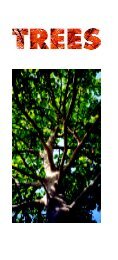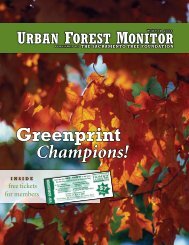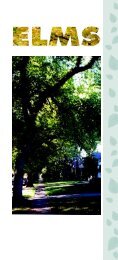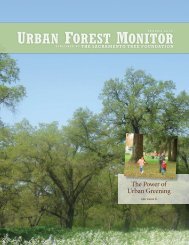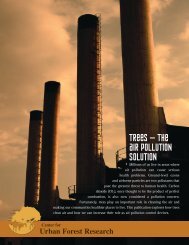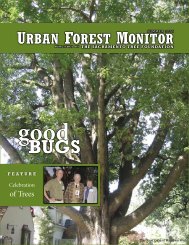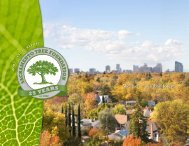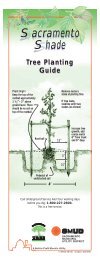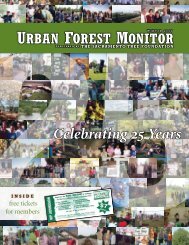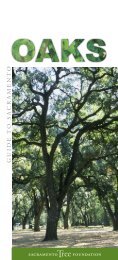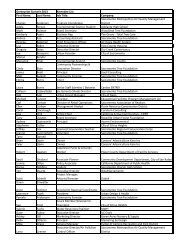Improving Fire Hazard Assessment at the Urban-Wildland Interface ...
Improving Fire Hazard Assessment at the Urban-Wildland Interface ...
Improving Fire Hazard Assessment at the Urban-Wildland Interface ...
You also want an ePaper? Increase the reach of your titles
YUMPU automatically turns print PDFs into web optimized ePapers that Google loves.
North Central, and Sierra. It had no effecton <strong>the</strong> 0% defensible space compliance r<strong>at</strong>efor Heavenly.Irrig<strong>at</strong>ionOver half <strong>the</strong> parcels citywide had irrig<strong>at</strong>ionon less than half of <strong>the</strong> veget<strong>at</strong>ion found on<strong>the</strong> parcel. The veget<strong>at</strong>ion in <strong>the</strong> Keys,which was domin<strong>at</strong>ed by turf grass andplanted exotics, was well irrig<strong>at</strong>ed, whileover 75% of <strong>the</strong> parcels in Heavenly, whichwere domin<strong>at</strong>ed by n<strong>at</strong>ive conifer stands,showed little evidence of irrig<strong>at</strong>ion. Lessthan one third of <strong>the</strong> parcels in <strong>the</strong> NorthCentral neighborhood were irrig<strong>at</strong>ed. From41% - 55% of <strong>the</strong> parcels in <strong>the</strong> o<strong>the</strong>rneighborhoods were irrig<strong>at</strong>ed.SlopeMost of <strong>the</strong> parcels th<strong>at</strong> were sampledexisted on little or no slope, with <strong>the</strong>exception of parcels in Heavenly, where <strong>the</strong>mean was 15% and <strong>the</strong> range was from 0%to 53%.Wall m<strong>at</strong>erialThe preferred building m<strong>at</strong>erial for homes inSouth Lake Tahoe was wood. 96% of <strong>the</strong>homes in <strong>the</strong> sample had exterior walls th<strong>at</strong>were shakes, logs, or wood siding. Thirteenpercent of <strong>the</strong> homes in <strong>the</strong> Keys werepredominantly brick, stucco, or stone, butfrom 95 – 100% of <strong>the</strong> homes in <strong>the</strong>remaining neighborhoods had woodexteriors.Roof m<strong>at</strong>erialCitywide, 31% of <strong>the</strong> sampled homes had asignificant increase in susceptibility toignition because of wood roofs.Neighborhoods where more than half <strong>the</strong>homes had wood roofs were North Central(54%) and Heavenly (56%). The fewestnumber were found in <strong>the</strong> neighborhood of<strong>the</strong> Y (18%).Window panesCitywide, 29% of <strong>the</strong> sampled homes hadincreased fire hazard due to <strong>the</strong> presence ofsingle-paned glass in over half <strong>the</strong> windowsof <strong>the</strong> home. The highest percentage ofhomes th<strong>at</strong> had predominantly single-panedwindows was in <strong>the</strong> neighborhood of <strong>the</strong> Y(41%), while <strong>the</strong> lowest was in Heavenly(22%).<strong>Hazard</strong>ous decks<strong>Hazard</strong>ous decks were found on 67% of <strong>the</strong>homes citywide. Deck construction andplacement was particularly problem<strong>at</strong>ic inHeavenly, where slopes were gre<strong>at</strong>est. Inth<strong>at</strong> neighborhood, eight of <strong>the</strong> nine parcelssampled had hazardous decks. In Bijou only48% of <strong>the</strong> homes had hazardous decks,while 60 – 73% of <strong>the</strong> homes in <strong>the</strong>remaining neighborhoods had hazardousdecks.DiscussionThe results of this study clearly indic<strong>at</strong>e th<strong>at</strong>standard city-scale fire hazard r<strong>at</strong>ing inSouth Lake Tahoe will not providemanagers and planners with sufficientlydetailed inform<strong>at</strong>ion to implement aneffective fire hazard mitig<strong>at</strong>ion program.While <strong>the</strong> city’s infrastructure is good,individual homeowners in <strong>the</strong> communityrarely choose for fire safety in terms ofconstruction m<strong>at</strong>erials, propertymaintenance, and landscaping or defensiblespace. The problem of non-compliance isworsened by <strong>the</strong> fact th<strong>at</strong> many of <strong>the</strong> city’slots are so small <strong>the</strong>y are influenced by <strong>the</strong>fire hazard of neighboring lots.Fur<strong>the</strong>rmore, results indic<strong>at</strong>e th<strong>at</strong> firehazard r<strong>at</strong>ing should be improved toaccount for <strong>the</strong> fire hazard cre<strong>at</strong>ed byneighboring veget<strong>at</strong>ion and houses in areasdomin<strong>at</strong>ed by small lots. Also, eachcomponent of a fire hazard r<strong>at</strong>ing systemshould produce results than can be used asdecision support for fire management,including identifying priority areas fortre<strong>at</strong>ment, identifying problem<strong>at</strong>ic areas in8




